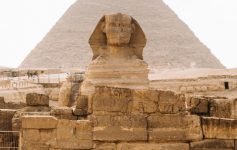Greece is one of the best countries in the world, where every stone, each island has its history and its own unique value.You need to travel in Greece thoughtfully, pausing and looking at every ruin, having a cup of coffee in any of the favorite cafes, staying at night in a small or a large comfortable hotel, swimming in the sea and then returning to the city to embrace civilization, which existed and flourished here long before the emergence of the first Russian cities.

If you follow the ancient tradition, then the journey to Greece is worth starting at Delphi. Here, at the foot of Mount Parnassus there is the most important oracle of ancient Greece, without the blessing of which not a single significant enterprise was started. The place was also considered as the center of the universe. Where else to begin the path through Greece, if not from Delphi?

Usually, tourists visiting Athens, go to one of the most famous monuments of the country – Acropolis. The temple complex in Athens, which reached its culmination in the V century BC, often disappoints travelers. Especially now, when the Parthenon is partly covered with forest, the temple is under restoration, and Acropolis is unavailable due to the strikes of employees. But Athens is not only Acropolis, while Acropolis has long become the symbol of Athens. The solemn ceremonies held at Acropolis, were only part of the turbulent life of the homeland of democracy.

The most densely populated area was located west of the temple hill, where the street of Apostle Paul now runs. Between the two hills of Muses and Nymphs, on Pnikse, in V and IV century BC, people’s congresses were held in Athens. The word “pniks” itself means “crush”. Here on the terrace, in front of the rocky elevation, on which the orators held their speeches, were gathered up to 15 thousand people, all citizens of Athens. From this rostrum Pericles, Femistokl, Demosfen were appealing to the citizens, turning to the temples, and calling the gods to be witnesses. It is worth to see Acropolis especially from this spot, if you want to feel for a moment how the time turns back.

Another look at Acropolis should be taken from the hill of the Muses, which is now called Filopappou hill, renamed in honor of Prince Kommagena, disgraced and exiled to Athens in the II century BC. The disgraced consul did everything in his power to improve the former great city and earned the love and respect of Athenians. But not for the sake of the Filopappu monument it is worth to come into this semi-wild park in the center of Athens. It was here that in 1687 the Venetian commander Francesco Morozini ordered the shooting of the Parthenon occupied by the Turks. There was a gunpowder storehouse in the temple, and the priceless monument, which had safely endured more than two millennia, was destroyed when the Turkish ammunition exploded.

You cannot leave Attica and not have a look at the temple of Poseidon, situated at Cape Sounion. The majestic temple of the sea god was built in 440 BC on the rock, from which, as the legend has it, Aegeus jumped into the sea, upon seeing the black sails on board of the ship bringing back his son. According to the myth, Theseus, after defeating Minotaur, forgot to change the sails of mourning, and the joy of the destruction of the monster was fairly ruined by this tragedy.

Corinth, located on the isthmus between Greece and Peloponnesus, was once the wealthiest trading city of Greece. Through the city was carried out the trade between the east and west of Greece. Here it is worth to visit the remains of the temple complex of Apollo built in 550 BC and a Greek fountain, restored by the Romans, which still supplies fresh water to local residents. While most of the monuments in the area of excavation refer to the Roman period, even today it is possible to form an idea about the size of the mega-city.

Mycenae and Tiryns relate to an earlier period in the history of Greece and should be examined along with the monuments of Crete, at the same time admiring the differences in approach of the archaeological excavations of Schliemann and Evans.

Another place in Greece, which still has an impact on our culture, is Olympia. The first sanctuary in Olympia, was located at the foot of Kronion and was dedicated to the goddess of the earth – Hera. Then, here came the cult of Zeus and the Olympic Games, during which all the wars tormenting the Greek cities stopped. Here are the remnants of the ancient stadium and the ruins of the temples of Zeus and Hera, treasuries that belonged to 12 different tribes, and buildings of later periods. The surviving sculptures, among them are the original work of Praxiteles – Hermes with the infant Dionysus, are stored in the Archaeological Museum of Olympia.

Greece is a country where there are many cultural monuments of different periods. There are mosques and Orthodox monasteries, buildings of Cretan-Mycenaean period and Roman monuments; this part of the land remains the cradle of European culture and everyone must visit it at least once. And even those travelers, who prefer the rest on beach to sightseeing, will not be able to resist the charm and the harmonious beauty of the monuments in Greece.


